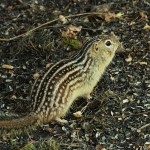gut
Photo by Donnie Ray Jones from Flickr creative commons.
A recent study published in Microbiome from researchers at the University of Alberta shows that babies from families with pets had nearly two-fold increases in the amount of two specific microbes in their guts, Ruminococcus and Oscillospira. These particular microbes are associated with reduced risks of developing childhood allergies as well as obesity. According to study author Dr. Anita Kozyrskyj, “There’s definitely a critical window of time when gut immunity and microbes co-develop, and when disruptions to the process…
Asian house shrew image by W.A. Djatmiko (Wie146) - Own work, CC BY-SA 3.0.
The stomach and small intestine of many species moves rhythmically during fasting, something called the rhythmic 'migrating motor complex', or MMC. The MMC has 3 phases: no contraction, intermittent small contractions followed by regular large contractions. These contractions are thought to help clean the GI tract by moving along debris and bacteria as well as preparing our guts for the next meal. They are also the cause of 'stomach rumbles' when we are hungry. If the time between…
The opening session was great!
By Tatsuo Yamashita (Flickr: ワンセグで紅白をみます 2012/12/31) [CC BY 2.0 (http://creativecommons.org/licenses/by/2.0)], via Wikimedia Commons
Eric Hoffman (Children's National Medical Center) presented work on chronic inflammatory diseases in children. He mentioned that while diets high in fats and carbohydrates (i.e. Western diets), obesity and sedentary lifestyles are associated with inflammation and related diseases (ex: asthma, type 2 diabetes), another contributor could be hormones. Kids who stay indoors more often have reduced exposure to …
By Hollingsworth John and Karen, U.S. Fish and Wildlife Service [Public domain], via Wikimedia Commons
Researchers are spending a lot of time exploring how the microbes living in our guts impact our health. In a new study published in Cell Reports, researchers wanted to know how the gut microbes of wild brown bears changes between summer and hibernation. They discovered that during the summer, the microbial species present in the gut are more diverse and are of the type that helps store energy. In fact, when the research team gave the microbes to rodents, the rodents gained…
Day 4 of the meeting turned out to be pretty exciting for a comparative physiologist as well.
The first session that I went to was called "RNASEQ approaches to understanding extreme physiological adaptations." Considering the Comparative and Evolutionary Physiology section business and dinner meeting was the night before, I was impressed at my ability to make it to an 8:00am session the following morning.
The first seminar from Dr. Brooke C Harrison (Univ. Colorado, Boulder) was on "Extreme cardiac growth and metabolism in the Burmese python after feeding." He spoke about how the cells…
"Even if there is only one possible unified theory, it is just a set of rules and equations. What is it that breathes fire into the equations and makes a universe for them to describe?" -Stephen Hawking
After a long search spanning more than my entire lifetime (so far), the Higgs boson has finally been discovered at both detectors -- CMS and ATLAS -- at the Large Hadron Collider at CERN.
Image credit: CERN / Particle Physics for Scottish Schools.
For a little more on this, check out the earlier posts here celebrating Higgs week:
The Biggest Firework of them all: The Higgs
How the…
The Not Exactly Pocket Science experiment continues after the vast majority of people who commented liked the pilot post. I'm really enjoying this, for quite unexpected reasons. It's forcing me to flex writing muscles that usually don't get much of a workout. Writing short pieces means being far more economical with language and detail than usual. It means packing in as much information as possible while still keeping things readable. And it means blitz-reading papers and writing quickly without losing any accuracy.
One quick note before the good stuff: last time, a few people suggested that…
You are outnumbered by a factor of 10 to one, by forces you cannot see. Your body has around ten trillion cells, but it's also home to a hundred trillion bacteria. For every gene in your genome, there are 100 bacterial ones. Most of these are found the dark, dank environment of your bowel but their incredible diversity is being brought to the surface. Say hello to the gut metagenome.
Together with a team of international scientists, Junjie Qin and Ruiqiang Li from BGI-Shenzen had the unenviable task of studying the bacteria from the faeces of 124 Europeans. They used a formidable and…


